Learning about Salmon
Washington is home to Chinook, chum, coho, sockeye, and pink salmon, and to steelhead and bull trout. In addition, several sub-species have specific runs and habitat throughout the state.
 Chinook salmon are the largest Pacific salmon and can live up to seven years. Chinook have highly diverse life history strategies: some spend more than a year in freshwater as juveniles, while others migrate to estuaries or the ocean after just a few weeks. Some populations return as adults to freshwater in early spring while other populations return in summer through late fall. Chinook are the preferred food of Southern Resident orcas and many humans, who covet their rich, oily meat. Chinook populations have decreased in recent decades across the species’ range. In Washington, Endangered Species Act protections apply to Snake River spring/summer and fall Chinook, upper Columbia River spring Chinook, lower Columbia River Chinook, and Puget Sound Chinook, while several wild populations are more robust.
Chinook salmon are the largest Pacific salmon and can live up to seven years. Chinook have highly diverse life history strategies: some spend more than a year in freshwater as juveniles, while others migrate to estuaries or the ocean after just a few weeks. Some populations return as adults to freshwater in early spring while other populations return in summer through late fall. Chinook are the preferred food of Southern Resident orcas and many humans, who covet their rich, oily meat. Chinook populations have decreased in recent decades across the species’ range. In Washington, Endangered Species Act protections apply to Snake River spring/summer and fall Chinook, upper Columbia River spring Chinook, lower Columbia River Chinook, and Puget Sound Chinook, while several wild populations are more robust.
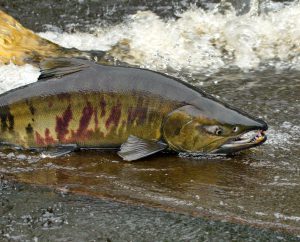 Chum salmon are a colorful, locally abundant species in coastal rivers, Puget Sound, Hood Canal, and the Columbia River. Juvenile chum migrate to the ocean almost immediately after emerging from their natal gravels, generally returning three to four years later to spawn. In Washington, chum favor lower river habitats with upwelling water, particularly in areas scoured by ice-age glaciers. Chum often are targeted for their large eggs, cured and eaten as caviar. In Washington, Endangered Species Act protections apply to lower Columbia River chum and Hood Canal summer chum, while abundant wild Puget Sound fall chum support recreational and commercial fishing.
Chum salmon are a colorful, locally abundant species in coastal rivers, Puget Sound, Hood Canal, and the Columbia River. Juvenile chum migrate to the ocean almost immediately after emerging from their natal gravels, generally returning three to four years later to spawn. In Washington, chum favor lower river habitats with upwelling water, particularly in areas scoured by ice-age glaciers. Chum often are targeted for their large eggs, cured and eaten as caviar. In Washington, Endangered Species Act protections apply to lower Columbia River chum and Hood Canal summer chum, while abundant wild Puget Sound fall chum support recreational and commercial fishing.
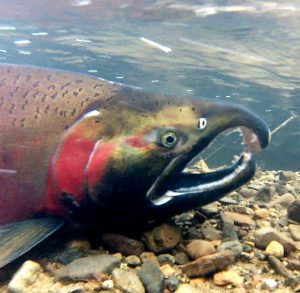 Coho salmon, like their close relative the Chinook, are popular targets for sport and commercial fishing. Coho generally spawn in small streams and spend a year in freshwater before migrating to the ocean. Most return as three-year-old adults. In Washington, Endangered Species Act protections apply to lower Columbia River coho. Snake River and mid-Columbia River coho are being reintroduced after being driven to extinction. Tribally led efforts to reintroduce coho in several Columbia River watersheds are showing promise, and more abundant populations persist in Puget Sound and on the Coast.
Coho salmon, like their close relative the Chinook, are popular targets for sport and commercial fishing. Coho generally spawn in small streams and spend a year in freshwater before migrating to the ocean. Most return as three-year-old adults. In Washington, Endangered Species Act protections apply to lower Columbia River coho. Snake River and mid-Columbia River coho are being reintroduced after being driven to extinction. Tribally led efforts to reintroduce coho in several Columbia River watersheds are showing promise, and more abundant populations persist in Puget Sound and on the Coast.
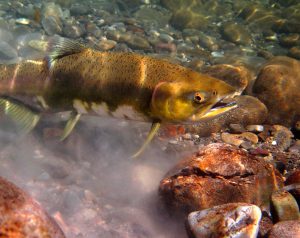 Pink salmon are the smallest and most abundant Pacific salmon throughout their native range. Like their close relative chum salmon, pinks spend very little time in freshwater after emerging from the gravel. Unlike other salmon that spawn at various ages, pinks only return to their rivers as two-year-old adults. In Washington, this results in abundant runs of adult pink salmon during odd years, while in even years they are almost absent. Pink salmon are harvested in large numbers and used for affordable, processed salmon products such as salmon patties or frozen fillets. Pink salmon populations are considered healthy throughout their ranges.
Pink salmon are the smallest and most abundant Pacific salmon throughout their native range. Like their close relative chum salmon, pinks spend very little time in freshwater after emerging from the gravel. Unlike other salmon that spawn at various ages, pinks only return to their rivers as two-year-old adults. In Washington, this results in abundant runs of adult pink salmon during odd years, while in even years they are almost absent. Pink salmon are harvested in large numbers and used for affordable, processed salmon products such as salmon patties or frozen fillets. Pink salmon populations are considered healthy throughout their ranges.
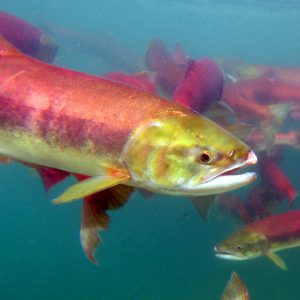 Sockeye, like chum and pink salmon, are near the southern end of their ranges in Washington State. Prized for their deep red meat, sockeye populations that are not Endangered Species Act-listed are targeted by tribal, commercial, and sport fishers along the Coast, Columbia River, and a few rivers in Puget Sound. Sockeye juveniles spend substantial time in lakes, a unique life history choice for Pacific salmon. Further north, sockeye form the backbone of the Bristol Bay fishing industry in western Alaska, where tens of millions of fish are harvested annually. Lake Ozette sockeye are protected by the Endangered Species Act in Washington, as are Snake River sockeye, which pass through Washington en route to their spawning areas in Idaho.
Sockeye, like chum and pink salmon, are near the southern end of their ranges in Washington State. Prized for their deep red meat, sockeye populations that are not Endangered Species Act-listed are targeted by tribal, commercial, and sport fishers along the Coast, Columbia River, and a few rivers in Puget Sound. Sockeye juveniles spend substantial time in lakes, a unique life history choice for Pacific salmon. Further north, sockeye form the backbone of the Bristol Bay fishing industry in western Alaska, where tens of millions of fish are harvested annually. Lake Ozette sockeye are protected by the Endangered Species Act in Washington, as are Snake River sockeye, which pass through Washington en route to their spawning areas in Idaho.
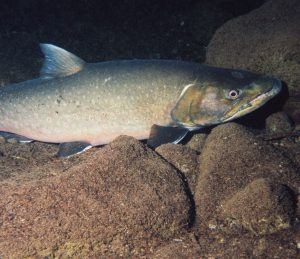 Bull Trout are more closely related to brook trout and arctic char than Pacific salmon. Bull trout live complex lives. Some travel to saltwater as adults, while others spend their entire lives in freshwater, sometimes spending their adult years in reservoirs. All bull trout populations in Washington are Endangered Species Act-listed, and all require extremely cold, clean water to survive. Bull trout populations are found throughout the state.
Bull Trout are more closely related to brook trout and arctic char than Pacific salmon. Bull trout live complex lives. Some travel to saltwater as adults, while others spend their entire lives in freshwater, sometimes spending their adult years in reservoirs. All bull trout populations in Washington are Endangered Species Act-listed, and all require extremely cold, clean water to survive. Bull trout populations are found throughout the state.
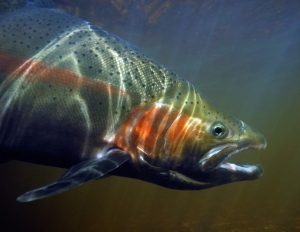 Steelhead are a type of rainbow trout that migrates to the ocean to grow to adulthood. Unlike their other Pacific salmon relatives, steelhead do not always die after spawning and can sometimes return to their natal rivers to spawn several times. Steelhead juveniles rear in freshwater longer than other salmon, often for two or more years before migrating to the ocean. Adults return to rivers throughout the year, with major run peaks in winter and summer, depending on the population. Steelhead are popular sport fish throughout their ranges. Endangered Species Act protections apply to lower, middle, and upper Columbia River steelhead, Snake River steelhead, and Puget Sound steelhead in Washington. The last populations of steelhead in Washington without Endangered Species Act protection are on the Washington Coast, where returns have been poor in recent years.
Steelhead are a type of rainbow trout that migrates to the ocean to grow to adulthood. Unlike their other Pacific salmon relatives, steelhead do not always die after spawning and can sometimes return to their natal rivers to spawn several times. Steelhead juveniles rear in freshwater longer than other salmon, often for two or more years before migrating to the ocean. Adults return to rivers throughout the year, with major run peaks in winter and summer, depending on the population. Steelhead are popular sport fish throughout their ranges. Endangered Species Act protections apply to lower, middle, and upper Columbia River steelhead, Snake River steelhead, and Puget Sound steelhead in Washington. The last populations of steelhead in Washington without Endangered Species Act protection are on the Washington Coast, where returns have been poor in recent years.
Salmon Life Cycle
Salmon are a remarkable species that play a vital role in the Pacific Northwest. They spend their life making an incredible migration from freshwater, out to the ocean, and back to the stream where they were born. During this journey, salmon go through several life stages.
Salmon are anadromous. This means they start their lives in freshwater, migrate to the ocean where they grow, then return home to their natal, or birth, streams to spawn and die.
There are five species of salmon that live in Washington waters: Chinook, chum, coho, sockeye, and pink. These Pacific salmon species may differ in their life histories, but they all follow a general cycle and have similar habitat requirements to survive.
See below to learn about the different phases of the salmon life cycle.

Eggs: Salmon begin their lives as tiny eggs in freshwater streams and rivers. Fertilized eggs lay in redds, or gravel beds dug out along the streambed, where the flow of water provides oxygen and removes excess sediment or waste products. The eggs will remain buried in the gravel until they are developed enough to emerge.

Alevins: Eggs “hatch” into tiny salmon called alevins. Alevins have their egg yolk sac attached to their bellies. The yolk sac continues to provide nutrients as the alevins grow. For a few months, alevins rely on their yolk sac and cover from the surrounding gravel until they are large enough to swim away from the redd.
 Fry: After alevins have fully absorbed their yolk sac, they become fry. Once fry have left their redd, they search for food and try to avoid being eaten. During this stage, fry may begin moving from freshwater to saltwater. Each species may spend a different amount of time developing before beginning migration from freshwater to saltwater.
Fry: After alevins have fully absorbed their yolk sac, they become fry. Once fry have left their redd, they search for food and try to avoid being eaten. During this stage, fry may begin moving from freshwater to saltwater. Each species may spend a different amount of time developing before beginning migration from freshwater to saltwater.

Smolt: At some point, fry pick up environmental cues and begin their migration to the ocean. This migration requires fry to go through a physical change, allowing them to survive in the ocean’s saltwater. At this stage, the salmon are called smolts. They grow new scales, giving them a silvery color. This is the last time salmon will be in freshwater until they are ready to spawn.
 Adults: Now in saltwater, salmon continue to look for food. Adult salmon can stay in the ocean, depending on species, anywhere from one to eight years. Much like their initial transition, salmon pick up new cues to return to the streams where they were born.
Adults: Now in saltwater, salmon continue to look for food. Adult salmon can stay in the ocean, depending on species, anywhere from one to eight years. Much like their initial transition, salmon pick up new cues to return to the streams where they were born.

Spawning and Death: Once adult salmon have begun their migration back to freshwater, their bodies undergo more changes to prepare for spawning. Spawners adapt to freshwater, their coloring changes, and some grow humped backs or hooked jaws. The journey back to their natal streams is incredibly challenging, not only because of the changes they undergo but also because of the challenges they face returning upstream. Once salmon end their journey and leave fertilized eggs in new redds, they have completed their lifecycle and die shortly after.
The salmon carcasses then are distributed by the river’s current along the watershed to provide nutrients to other species and habitat. These dead salmon are particularly special to the surrounding environment because they release nutrients from the ocean.
Fish photographs
- Chinook by Jess Newley, Friends of the San Juans
- Chum by K. KING, U.S. Fish and Wildlife Service
- Coho, pink, and sockeye by John R. McMillan, National Oceanic and Atmospheric Administration’s National Marine Fisheries Service, West Coast
- Bull trout by Roger Tabor, U.S. Fish and Wildlife Service
- Steelhead by the Washington Department of Fish and Wildlife
Life Cycle Photographs
- Eggs courtesy of South Puget Sound Salmon Enhancement Group
- Alevin by Jeffery Rich
- Fry by John McMillan, National Oceanic and Atmospheric Administration’s National Marine Fisheries Service, West Coast
- Smolt by Mike Peterson, National Oceanic and Atmospheric Administration’s National Marine Fisheries Service, West Coast
- Adult chum salmon taken by Paul Vecsei
- Spawning and Deaths by John McMillan, National Oceanic and Atmospheric Administration’s National Marine Fisheries Service, West Coast
